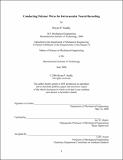| dc.contributor.advisor | Ian W. Hunter. | en_US |
| dc.contributor.author | Ruddy, Bryan P. (Bryan Paul), 1983- | en_US |
| dc.contributor.other | Massachusetts Institute of Technology. Dept. of Mechanical Engineering. | en_US |
| dc.date.accessioned | 2007-01-10T15:38:18Z | |
| dc.date.available | 2007-01-10T15:38:18Z | |
| dc.date.copyright | 2006 | en_US |
| dc.date.issued | 2006 | en_US |
| dc.identifier.uri | http://hdl.handle.net/1721.1/35308 | |
| dc.description | Thesis (S.M.)--Massachusetts Institute of Technology, Dept. of Mechanical Engineering, 2006. | en_US |
| dc.description | This electronic version was submitted by the student author. The certified thesis is available in the Institute Archives and Special Collections. | en_US |
| dc.description | Includes bibliographical references (leaves 32-34). | en_US |
| dc.description.abstract | Brain-machine interfaces are a technology with the potential to fundamentally change the way people interact with their environment, but their adoption has been hampered by the invasiveness of conventional implanted cortical microelectrode arrays. Llinás et al. have proposed a novel design for intravascular nanowire electrode arrays, which promise to be less invasive than current technology. Early work utilizing platinum nanowires showed that metal wires are too stiff for this application. Conducting polymer nanowires could be used in place of metal to build electrodes with far lower stiffness and high conductivity. This thesis describes several all-polymer electrode architectures and the fabrication techniques used to build them. Polypyrrole microwire electrodes were first built in order to demonstrate the feasibility of an all-polymer neural recording electrode, and were shown to give high-fidelity intravascular recordings. Polyaniline nanowires were then fabricated by coaxial electrospinning, which was shown to be a viable technique for the manufacture of such wires. These wires will be integrated to form complete nanowire electrodes and tested in animals before moving towards human applications. | en_US |
| dc.description.statementofresponsibility | by Bryan P. Ruddy. | en_US |
| dc.format.extent | 35 leaves | en_US |
| dc.format.extent | 3507389 bytes | |
| dc.format.extent | 3506230 bytes | |
| dc.format.mimetype | application/pdf | |
| dc.format.mimetype | application/pdf | |
| dc.language.iso | eng | en_US |
| dc.publisher | Massachusetts Institute of Technology | en_US |
| dc.rights | M.I.T. theses are protected by copyright. They may be viewed from this source for any purpose, but reproduction or distribution in any format is prohibited without written permission. See provided URL for inquiries about permission. | en_US |
| dc.rights.uri | http://dspace.mit.edu/handle/1721.1/7582 | |
| dc.subject | Mechanical Engineering. | en_US |
| dc.title | Conducting polymer wires for intravascular neural recording | en_US |
| dc.type | Thesis | en_US |
| dc.description.degree | S.M. | en_US |
| dc.contributor.department | Massachusetts Institute of Technology. Department of Mechanical Engineering | |
| dc.identifier.oclc | 76702257 | en_US |
